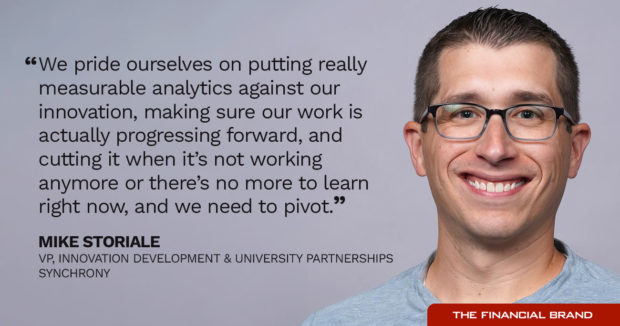Some of the areas that Mike Storiale’s product incubation team delves into are just beyond the leading edge — like Web 3 digital wallets.
But Synchrony’s innovation lab has a method to help it balance work on those futuristic concepts with what is more relevant now.
Storiale likes to call this process staying in the “strike zone.”
“We define that strike zone with a whole lot of data and metrics to make sure we’re not just chasing shiny objects,” says Storiale [pron. “Story-aly”], whose corporate title is vice president for innovation development and university partnerships. He also heads Synchrony’s Emerging Technology Center at University of Illinois Urbana-Champaign.

Improve Your Business Outcomes Through Data & Analytics
Gain centralized access to the credit bureaus and 20+ alternative data sources. Leverage advanced analytics to optimize marketing campaigns and loan decisions.
Read More about Improve Your Business Outcomes Through Data & Analytics

Creating A Community with CQRC’s Branch Redesign
Find out how SLD helped CQRC Bank to create the perfect harmony of financial services, local culture, and the human touch in their branch transformation.
Read More about Creating A Community with CQRC’s Branch Redesign
Staying in Synchrony’s Innovation ‘Strike Zone’
The strike zone at Synchrony is larger than it might for others in the banking industry, in part because the $112.9 billion-asset company is more specialized than most institutions its size. Though it operates a digital-only bank, it is better known as the nation’s largest issuer of private-label credit cards, with partners that include national and regional retailers, local merchants, manufacturers, buying groups, industry associations and healthcare service providers.
Outsiders might get the idea that innovation labs are all about inventing things and getting patents. As exciting as that may seem, Storiale says he often reminds team members that “innovation doesn’t always mean you’re using the latest and greatest technology. Sometimes you might be innovating on a new trend but using technology that you’ve had in your toolbox for a long time.”
Invention does happen, but Storiale says the urge to innovate must be balanced against the need to avoid chasing the wrong stuff or stuff that won’t be ready to use for a while and will require too much time and resources to get there.
Talk with Storiale for a while and you realize that sometimes what helps is remembering why you are innovating in the first place. If figuring out a good way to use existing technology to produce better service works, that’s innovation too.
Take the cloud. “What the consumer wants are better products,” says Storiale. “They didn’t realize that the products they were using got better because the company they were interacting with migrated everything to the cloud. They just knew the products got better.”
For Synchrony, another side of innovation is serving the needs, now and in the future, of its specialized clientele. Inevitably this comes back to improving service to consumers.
Web 3 is an example. Storiale thinks that in the long term Web 3 technology will improve online digital identification and make checkouts smoother.
“People will say, ‘Man, that was so much simpler than it used to be, I can’t believe it,'” says Storiale. “And then they won’t even really give it a second thought.”
When to Push, When to Pivot, All Part of Financial Innovation
In fact, Storiale thinks that when an innovation team is really doing its job right, it becomes somewhat invisible. “Incubation,” to him, means just that — carrying an idea forward far enough to prove its potential, and then handing it off to the experts in a line of business unit who can work to scale it up.
That’s where the concept of the “minimum viable product” comes in — putting something on the street with just enough features for early adopters and seeing where things go from there.
Knowing when to pivot and when to stop are critical — but neither necessarily means forever.
Storiale gives an example. A few years before the pandemic hit, his unit was working with a concept that would in the future be called “embedded banking.” The project began as retailers’ tech stacks began to grow in sophistication. Integrating banking seemed natural.
The technology was developed and put in place with a pilot group of Synchrony’s card partners. “The market fit wasn’t quite there,” says Storiale.
So the research went on the shelf. Then Covid hit and remote commerce got to be important in a hurry. “We had a full-scale team take up that initial work we had incubated,” he says. The team built it out to scale.
“We’ve seen a lot of success with that product since,” Storiale says.
Read about other innovation labs:
- How U.S. Bank’s Innovation Team Gets a Read on the Future
- Even Innovation Itself Is Changing Inside Banks Now

On the Near Horizon: ‘Social Shopping’ and ‘Headless Commerce’
At any one time, the team might be working on between six and eight trends in its innovation strike zone, according to Storiale. Some have a short timeline, while others are further out on the horizon. Or, at least, they start that way.
Social commerce, also known as social shopping, is something Synchrony has been exploring of late. This is the buying and selling of goods and services directly within a social media platform. (It’s one of the things Elon Musk has in mind for X, formerly known as Twitter, which he wants to build into a financial and ecommerce superapp.)
“As you can imagine, right now social commerce is significantly impactful to many of our partners,” says Storiale. “We want to understand more about how new generations are going to shop. To be honest, not just new generations, but probably all generations now.”
Part of what’s being studied is the role of microbrands and microinfluencers on buying patterns. Synchrony’s retail partners want to capitalize on this trend, so the company is trying to develop the right product approaches to facilitate that.
“A lot goes into clicking that button. Any of our retail partners will tell you that getting somebody to click is a journey. There’s a lot in the consumer psyche that goes into it. We’re going to learn a lot about it in the next year or two.”
— Mike Storiale, Synchrony
Synchrony has different proofs of concept in the works, some of which have advanced to minimum viable products. Storiale projects that this area will become hot in 2025 or 2026. He says many retailers will likely attempt to not only get aboard social commerce, but to tie it into their websites and mobile apps, perhaps as a tab that will pull potential buyers right into the social channel.
Another trend on the near horizon is “headless commerce.” This term, roughly a decade old, refers to the idea that the front end of a digital sales channel needs to be uncoupled from the back end. In broad strokes, the idea is that the back-end engine needs to do many things right that the consumer doesn’t need to see, and this heavy lifting should not delay implementing innovations on the front end. Storiale says this is something that has become more important to partners and therefore to Synchrony.
Read all of our most recent coverage of banking innovation.

Community Bankers’ Top Priorities This Year
CSI surveyed community bankers nationwide to learn their investments and goals. Read the interactive research report for the trends and strategies for success in 2024.

The unfair advantage for financial brands.
Offering aggressive financial marketing strategies custom-built for leaders looking to redefine industry norms and establish market dominance.
Further Out: Web 3 Digital Wallets and More Blockchain Innovation
Something that Storiale has learned to do is separate the strands of trends to see what elements can be worked with on their own. A good example of that is Web 3 technology and, more broadly, blockchain technology.
Right now, in many quarters, talking to bankers about the metaverse is a good way to have a short conversation. The only topic even less interesting would be cryptocurrency, which is still having its “winter.”
Storiale says it’s important to distinguish the potential of the underlying technology from the baggage they carry due to current events.
Web 3 is the next iteration of web technology, something that Storiale says will enable ownership of digital assets to be reliably assigned and that will enable digital identities to be tracked and proven on a decentralized basis. The latter is important because, long term, identity and ownership will need to be portable from one metaverse to another. Storiale is among those who believe that when the metaverse becomes more mainstream, there will be many versions of it. In a sense, portable, iron-clad credentials will be as important to move from one to another as a passport is to moving from one country to another.
That portability will become important to retailers and others that want to sell things in the metaverse. Storiale has his team studying Web 3 and tools such as Web 3 digital wallets. In Synchrony’s strike zone, they are considered to be on the mid-term to furthest-out horizons.
But this work could pay off in other ways in the short term.
Read more about Web 3:
- Explainer: What Is Web 3.0? (And Why Should Banks Care?)
- Which Emerging Bank Tech Should You Consider? And Which Might Never Pay Off?

Synchrony Sees Promise in Digital Identity
Storiale thinks aspects of Web 3 could be used to improve digital identification soon. This would be useful for digital banking as well as digital payments.
At one time, back when nothing was digital, having a bank vouch for someone was critical in commerce. A letter from a bank was a passport of sorts to acceptance.
Storiale says if banks can take a lead in Web 3 identification, it could put them at the center of digital identification in the future. “There could be a world in the future where people could say, ‘Hey, my bank can identify me and prove to you that I am who I say I am.”
Between now and then, Synchrony will be exploring the technology to see how to bring out its potential. This is a time to test its viability. Later on, it could become yet another trend where the innovators remain unknown, but customers just know things work better.








